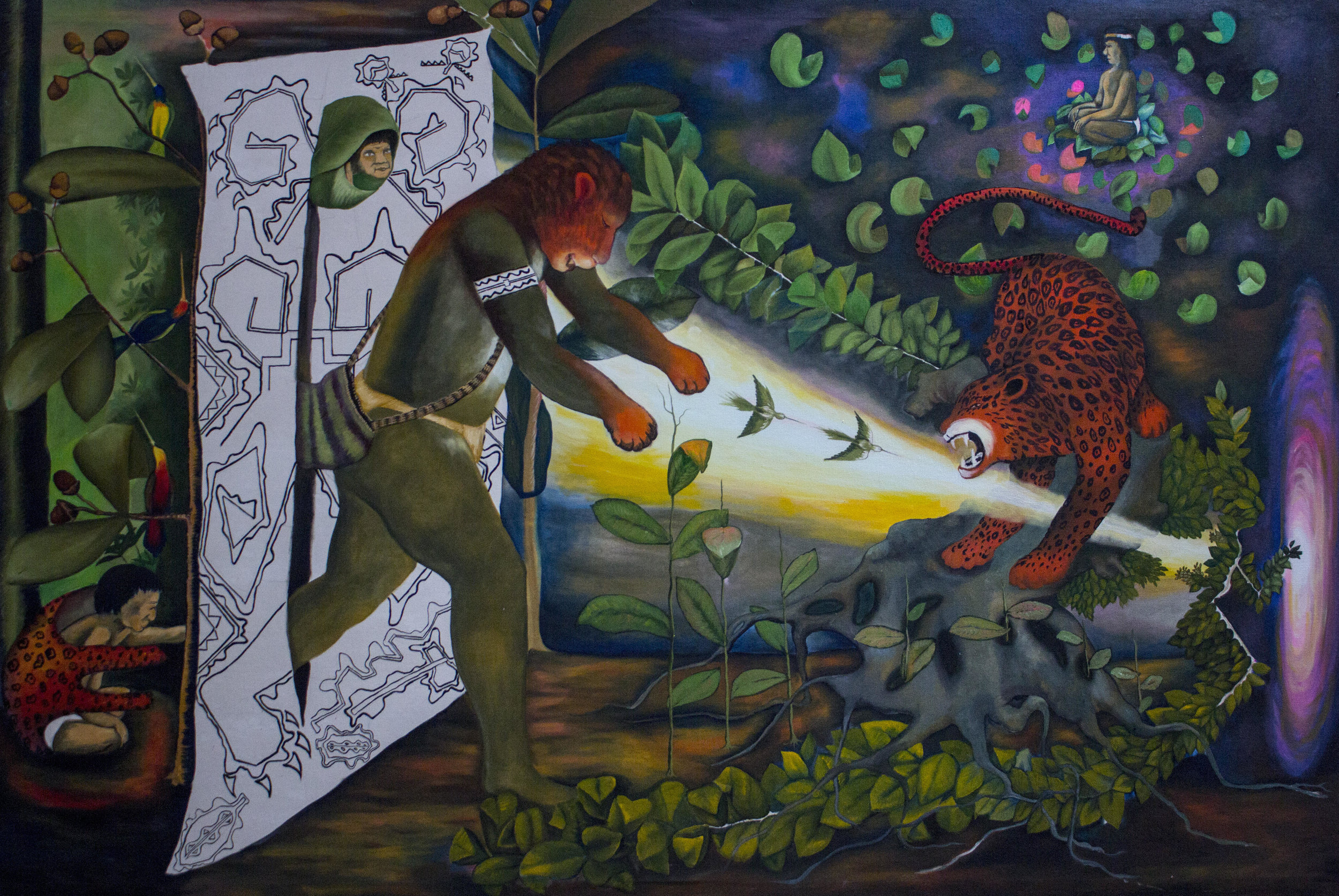The Invisible Forest at Gallery 46 brings together work from Peruvian-Amazonian artists, including Brus Rubio Churay, Santiago Yahuarcani, Lastenia Canayo, and Elena Valera. Curator Patsy Craig hopes viewers learn by example the importance of environmental stewardship.
Encuentro con los aliados, 2018. Brus Rubio.
The Amazon rainforest, often described as ‘the lungs of our planet’, is thought to generate around 20% of the world’s oxygen. Through the forest runs the mighty Amazon River, the life blood whose tributaries feed the region’s incredible flora and fauna and the remote communities who call it home. It’s little wonder that nature plays such a vital role in these cultures’ cosmologies.
“The forest is currently invisible,” says artist Brus Rubio Churay, “but we need to make it visible.” Brus is currently the artist-in-residence at Gallery 46, Whitechapel. His paintings are being exhibited there alongside work from fellow Peruvian-Amazonian artists, in the aptly named group show, The Invisible Forest.
Evident in many of the works on display is the importance of environmental stewardship to these communities, and their connection to nature. Plants are a vital part of their daily lives, which they rely on for nourishment, medicine and knowledge. The Murui use coca powder, a pure form of the plant, while the Shibipo are known for taking ayahuasca to gain greater clarity and vision.
Untitled. Santiago Yahuarcani.
Brus is from Pucaurquillo, a community in the basin of the Ampiyacu River in Loreto, Peru. Growing up near the river, he remembers the stories his family told him while fishing and at home under the starry Amazonian sky. These stories helped him foster a sensitivity towards nature, and reflect on the mysteries of life. “The Invisible Forest represents that respect towards the force of nature, that we hope to make visible through artistic expression.”
Three of Brus’ paintings are on display in this group exhibition. They depict a man’s transfiguration to jaguar. “This story is part of the learnings imparted to me by my uncle Alfonso, who was the kuraka (chief) of our community. This work is also about expressing respect for our ancestors.”
In 2002, the anthropologist Jürg Gasché visited Brus’s community to do fieldwork and learn about ancestor veneration. In turn, Brus learnt about Western anthropological thinking and the importance of conversing with different cultures. In the process, he discovered his passion for painting as a means for bridging those cultural divisions.
“Latin American art is usually closer to Andean art or pre-Hispanic iconography, but my art instead is from the perspective of my people, the Murui-Bora.” The artist is self-taught. He grew up in a remote part of the Amazon, and learnt about European art history from encyclopaedias and other books that started arriving when he was a child. “This made it easier to communicate more directly with a non-Indigenous audience.
The cosmology of Brus’s community is not well-documented, though often classed as animistic by anthropologists. “We believe in a great respect towards nature, towards animals—we are conscious of what nature provides us. That’s what we believe—in the force of nature itself. What I want to do is reach out to the West—the “rational” world which tries to understand much more about our intuition than we can actually say—and re-introduce this force of nature.”
Another objective of the group show is to tell the history of colonial bloodshed from their own perspective. “I’m from two ethnic groups —my father is Murui and my mother is Bora. The Murui and Bora peoples are known internationally for having been victims of the massacre taking place around the Amazon Rubber Boom (1879 to 1912), during which the London-based Peruvian Amazon Rubber Company massacred the Indigenous Amazonian peoples. This part of Amazonian history has not been told by Indigenous people, by us, but rather by people like British diplomat Roger Casement. It has not been given much attention by politicians or the Peruvian press. I aim to give these stories an Amazonian voice.”
La Astucia, 2017. Brus Rubio.
Curator Patsy Craig spent years living with Brus in his small Amazonian community. She became an advocate for Indigenous people’s rights after standing in alliance with Native American people over the water protection movement at Standing Rock, North Dakota, in 2016. “I thought I had to listen to what Indigenous people have to say. My mother was Peruvian and my father American. I have Native-American heritage on my father’s side and Indigenous blood from my mother’s side, so these issues are really close to me. The experience inspired me to learn more about Indigenous culture and provide more platforms to amplify Indigenous worldviews and knowledge.”
The Invisible Forest is part of the curator’s Flourishing Diversity Series, conceived in collaboration with the Centre for the Anthropology of Sustainability at the University College London, and the UK-registered conservation charity Synchronicity Earth. Their goal is to provide Indigenous people with a platform to speak about their relationship with the environment. “The dominant culture - the Western world - is destroying the environment,” continues Patsy. “How do we recover that relationship with nature, if there ever was one in our culture? One thing is really clear for me: Indigenous people are part of the solution to the climate crisis. Respect for nature is intrinsic to their worldview, and it has been for thousands of years. We need to start listening.”
The Invisible Forest is at Gallery 46 in Whitechapel, London, from Friday 1 June to Saturday 29 June 2019. Entry is free.
Hombre Garza. Rember Yahuarcani.




